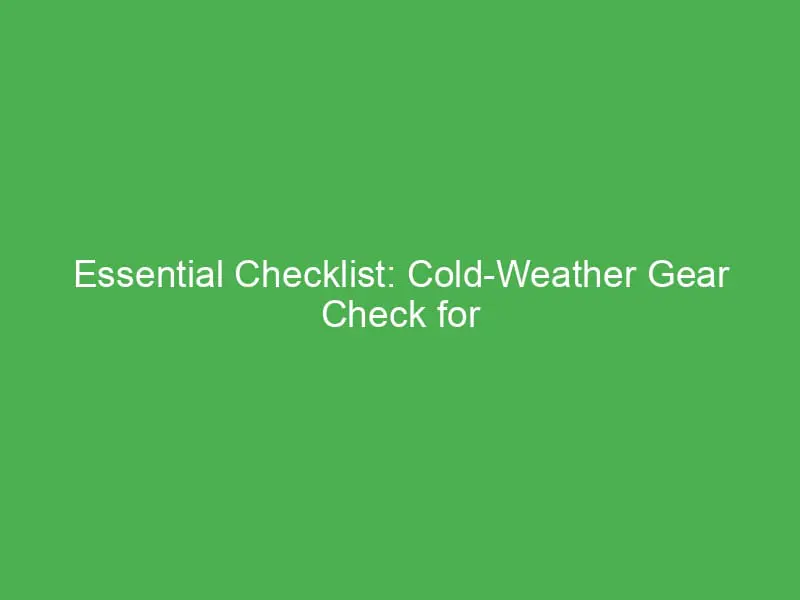As winter approaches and the allure of snowy slopes beckons, preparing for a ski trip becomes essential. For avid skiers, ensuring they have the right cold-weather gear can make all the difference between a thrilling adventure and a chilly disappointment. With temperatures plummeting and conditions changing rapidly, a well-thought-out checklist is crucial for a successful outing.
This article dives into the must-have gear for cold-weather adventures, helping skiers avoid common pitfalls. From thermal layers to essential accessories, having the right equipment not only enhances the skiing experience but also keeps everyone warm and safe. Whether it’s a weekend getaway or an extended alpine retreat, being prepared is the key to enjoying the slopes to the fullest.
Importance of Cold-Weather Gear
Cold-weather gear plays a crucial role in ensuring safety and comfort while skiing. Having the right equipment minimises the risk of hypothermia, frostbite, and other cold-related issues.
Key Benefits of Cold-Weather Gear
- Thermal Regulation: Cold-weather clothing uses advanced materials that insulate body heat while allowing moisture to escape. Layering is essential, including base layers, insulating mid-layers, and protective outer layers.
- Protection Against Elements: Quality gear safeguards against wind, snow, and rain. Waterproof and windproof jackets, along with durable trousers, are vital for keeping dry and warm.
- Enhanced Mobility: Proper fit and flexibility of gear help maintain mobility on the slopes. Lightweight, non-restrictive fabrics allow for unrestricted movement while skiing.
- Injury Prevention: Using protective gear such as helmets, knee pads, and wrist guards reduces the risk of injuries during falls or accidents.
- Comfort and Performance: Comfortable gear improves performance. When skiers feel good, they can focus on technique instead of discomfort.
Essential Cold-Weather Items
- Thermal Base Layers: Merino wool or synthetic options provide insulation.
- Insulating Mid-Layers: Fleece or down jackets add necessary warmth.
- Waterproof Outer Layers: GORE-TEX or similar products for wind and moisture resistance.
- Ski Socks: Merino wool and cushioned options will keep feet warm and comfortable.
- Warm Accessories: Hats, neck gaiters, and gloves maintain extremity warmth.
- Eyewear: Goggles with UV protection and a proper fit protect eyes from glare and wind.
Investing in quality cold-weather gear significantly enhances skiing experiences, ensuring trips are enjoyable and safe.
Essential Clothing Items
Selecting appropriate clothing items is vital for a successful ski trip, ensuring warmth and comfort throughout the experience. The following clothing layers provide essential protection against cold weather.
Base Layers
Base layers serve as the first line of defence against cold temperatures. Characteristics of effective base layers include:
- Moisture-wicking: Fabric, such as merino wool or synthetic materials, removes sweat from the skin.
- Thermal insulation: Provides warmth by trapping body heat close to the skin.
- Fitted design: Ensures a snug fit without restricting movement.
Examples of recommended base layer items are long-sleeve tops, leggings, and thermal tops. Ensure to check the thickness and fit, as they play a significant role in thermal regulation.
Insulation Layers
Insulation layers add essential warmth and can be adjusted based on activity level. Consider the following features:
- Loftiness: Fill power in down or synthetic insulation increases warmth-to-weight ratio.
- Breathability: Allows moisture and heat to escape, preventing overheating.
- Layering compatibility: Should fit comfortably over base layers without limiting movement.
Examples include fleece jackets, insulated vests, or lightweight down jackets. Prioritise items that balance warmth with packability for convenience.
Outer Layers
Outer layers offer protection against wind, rain, and snow. Key attributes to consider include:
- Waterproofing: Look for materials like Gore-Tex or other waterproof laminates.
- Wind resistance: Keeps chilly winds at bay to maintain core temperature.
- Durability: Reinforced stitching and tear-resistant fabrics prolong garment life.
Examples of effective outer layers include waterproof ski jackets, shell pants, and snow skirts. Ensure they have functional features, such as ventilation zips and multiple pockets, for added convenience.
Ski Equipment Checklist
Proper equipment ensures safety and performance on the slopes. The following sections detail essential ski gear.
Skis and Bindings
- Skis: Select skis that match skill level and terrain. Skis vary by type (all-mountain, freestyle, powder) and length, influencing manoeuvrability.
- Bindings: Ensure bindings are compatible with skis and boots. Check DIN settings, which affect release tension, for safety.
- Maintenance: Inspect skis for damage or wear, including edges and bases. Wax skis prior to trips for optimal glide.
Ski Boots
- Fit: Prioritise a snug fit for warmth and control. Boots should not pinch but provide minimal movement to improve responsiveness.
- Type: Choose between alpine, touring, or hybrid boots based on skiing style. Each type offers different flex and comfort levels.
- Liners: Consider heat-mouldable liners for a customised fit. Ensure liners are dry and clean before each trip.
Poles and Helmets
- Ski Poles: Select poles of appropriate length, generally aligning with the armpits when inverted. Adjustable poles offer versatility for varied terrain.
- Helmets: Use certified skiing helmets for safety. Ensure a proper fit, allowing room for a beanie or balaclava underneath.
- Accessories: Add a visor for sun protection and consider communication systems for group skiing. Check straps and vents to ensure functionality.
Accessories to Consider
Essential accessories enhance comfort and safety during ski trips. Including the right items in the packing list significantly improves the skiing experience.
Goggles and Sunglasses
Selecting the right eyewear protects eyes from UV rays and reduces glare on the snow. Goggles with anti-fog coatings and interchangeable lenses cater to varying light conditions. Factors to consider include:
- Lens Tint: Dark tints are ideal for bright days, while lighter tints suit overcast conditions.
- Fit and Comfort: Ensure a snug fit to avoid slippage and discomfort during movement.
- Ventilation: Good airflow prevents fogging and keeps vision clear.
Investing in high-quality goggles or sunglasses ensures clarity and protection on the slopes.
Gloves and Hats
Gloves and hats play a vital role in maintaining body warmth. Quality items should provide insulation and breathability. Key considerations are:
- Water Resistance: Look for gloves designed to repel moisture and keep hands dry.
- Insulation: Thicker materials offer better warmth but should not compromise dexterity.
- Hat Types: Choose a beanie or helmet liner that covers the ears; materials like fleece or wool provide excellent warmth.
Ensuring gloves and hats fit properly allows for enhanced comfort and protection against the cold.
Thermal Socks
Investing in quality thermal socks impacts foot comfort during skiing. Proper socks help regulate temperature and wick moisture away from the skin. Important factors include:
- Material: Wool or synthetic blends provide insulation and durability without bulk.
- Length: Knee-high or crew-length options prevent cold air from entering boots.
- Cushioning: Look for socks with cushioning in critical areas for added comfort during runs.
Wearing the right thermal socks prevents blisters and keeps feet warm throughout the skiing experience.
Maintenance and Preparation
Proper maintenance and preparation of cold-weather gear maximise functionality and extend the lifespan of equipment. Regular checks and upkeep are essential to ensure safety and performance on ski trips.
Gear Inspection
- Clothing: Examine base layers, mid-layers, and outer layers for signs of wear. Check for tears, zippers, and fastenings, ensuring all parts function correctly.
- Ski Equipment: Inspect skis for structural damage. Evaluate the bindings, ensuring they are properly adjusted to the skier’s weight and skill level.
- Ski Boots: Assess boots for cracks or wear in the shell and inspect the liners for comfort and insulation. Ensure buckles function smoothly.
- Poles and Helmets: Check ski poles for bends and ensure they are the correct length. Verify that helmets are free from cracks and have secure straps.
Cleaning Protocols
- Washing: Follow the manufacturer’s instructions for cleaning clothing and gear. Use appropriate detergents for technical fabrics to maintain breathability and insulation.
- Storage: Store gear in a cool, dry place to prevent mould and deterioration. Avoid placing equipment in damp or humid areas.
Preparation Tips
- Test Gear: Conduct a test run with gear before the trip. Wear clothing and equipment during a local skiing session to ensure comfort and functionality.
- Accessibility: Prepare a specific area for gear organisation. Keep essential items, like gloves and goggles, easily accessible to avoid delays on the slopes.
- Emergency Kit: Assemble an emergency kit that includes a first-aid kit, spare layers, and a repair kit. This preparation minimises risk during unexpected situations.
Equipment Modifications
- Heat-Moulding Boots: Consider heat-moulding ski boots for a customised fit. This enhances comfort and reduces the risk of blisters.
- Waxing Skis: Wax skis before the trip to enhance glide. Regularly inspect and re-wax throughout the season based on conditions.
These maintenance and preparation strategies not only enhance performance but ensure a safer and more enjoyable skiing experience.
Key Takeaways
- Essential Cold-Weather Gear: Proper thermal layers, waterproof outer layers, and insulating mid-layers are key to staying warm and safe on the slopes.
- Protection Against Elements: Quality gear protects against harsh weather conditions, reducing the risk of hypothermia and frostbite.
- Comfort and Mobility: Investing in well-fitting, lightweight gear enhances flexibility and performance while skiing.
- Ski Equipment Essentials: Ensure skis, bindings, and boots are compatible and well-maintained for safety and optimal performance.
- Importance of Accessories: Items like goggles, gloves, and thermal socks are crucial for comfort and protection during skiing.
- Maintenance and Preparation: Regular gear inspections and proper maintenance prolong equipment lifespan and enhance skiing experience.
Conclusion
Preparing for a ski trip is essential for an enjoyable experience on the slopes. A well-structured checklist ensures that all necessary cold-weather gear is accounted for, minimising the risk of discomfort or injury.
Investing in quality thermal layers, waterproof outerwear, and protective accessories can significantly enhance safety and performance. Regular maintenance of gear not only extends its lifespan but also optimises functionality.
By following the outlined preparation strategies, skiers can focus on what truly matters—the thrill of skiing and the beauty of winter landscapes. With the right gear and preparation, every ski trip can be a memorable adventure.
Frequently Asked Questions
Why is preparing for a ski trip important?
Preparing for a ski trip is crucial as it ensures you have the necessary gear and equipment to stay safe and comfortable on the slopes. A well-thought-out checklist helps avoid common mistakes and ensures you are equipped for various weather conditions, enhancing your overall skiing experience.
What types of cold-weather gear should I consider?
Essential cold-weather gear includes thermal base layers, insulating mid-layers, waterproof outer layers, ski socks, and warm accessories like gloves and hats. This gear is vital for thermal regulation, protection against elements, and overall comfort while skiing.
How do I choose the right ski equipment?
Select skis that match your skill level and preferred terrain. Ensure bindings are compatible and properly set. When choosing ski boots, look for a snug fit and consider the type based on your skiing style. Helmets should be certified for safety.
Looking for more sober travel inspiration? Find your next adventure on our Homepage.
What are the benefits of wearing thermal layers?
Thermal layers help regulate your body temperature by wicking moisture away from your skin and providing insulation. They are essential for keeping you warm and comfortable while reducing the risk of hypothermia and other cold-related issues.
How can I maintain my cold-weather gear?
Regular inspections of clothing, ski equipment, and accessories are essential for safety and performance. Follow proper cleaning protocols, store gear correctly, and test all equipment before your trip to ensure everything is functional and safe.
What should I include in my ski gear checklist?
Your ski gear checklist should include skiing essentials like skis, boots, poles, helmets, goggles, gloves, thermal socks, and appropriate clothing layers. Additionally, include safety items like a first aid kit, repair tools, and emergency supplies.
Why invest in quality ski gear?
Investing in quality ski gear enhances safety, comfort, and performance on the slopes. Better materials provide improved insulation and protection against harsh weather, helping to minimise injuries and maximise enjoyment during your ski trip.

Quit drinking on 23 July 2021 after a two-day bender and swapped bars for border crossings and 12-step meetings. Three sober years, 36 countries, 113 travellers (totally dry), fuelled by street food, jelly babies, and a broken Google Maps app. Wandersober is my journal, my SEO lab, and my mission. Featured in GQ, Mirror, Evening Standard, MarketWatch, and more.






